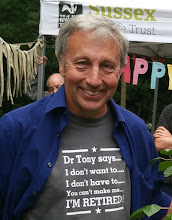Native, species-rich grasslands have suffered around a 97%
loss since the 1940s – a staggering rate of loss for any habitat so why have we
not heard more about it?
Perhaps one reason might be our reducing expectations.
Look out of the window and you would be forgiven for
thinking that there is grassland everywhere – so what is the fuss about! Well, it
seems that we have forgotten what grasslands can actually be like. A good “unimproved” grassland can be a riot
of colour – all sorts of species existing together in intimate mixtures. Literally dozens of flower species can exist in
an area that today might hold just two (perennial ryegrass and white
clover). Look at grasslands today and,
usually, the colour has gone. We see an
expanse of green, imagine that is all it can be and don’t expect to see
anything else. We don’t imagine better
so we don’t see the loss. This narrowing
of our horizons is perhaps more depressing than the actual loss.
Indeed calling these habitats “grasslands” at all is a
misnomer. There is not much grass in a
good ancient grassland – a better name would be pasture or meadow. We do however call them “unimproved” meadows
because they have not been re-seeded, fertilised or sprayed with pesticide. This means that a wider range of native
plants are able to survive.
Meadows, alive with colour, cut for hay and then grazed by
sheep or cattle, were a mainstay of mixed farming for centuries. You could argue that these habitats are just
not relevant to modern agriculture so perhaps they are just a relic of a
bygone age. This is certainly not a
criticism of farmers or farming, but the world has moved on.
I do not hold with this view, however, and perhaps the world
should move on again.
These habitats are now so rare that even if we offered a
very lucrative incentive scheme to farmers for each surviving fragment just to
save threatened meadow flowers it would be a small price to pay.
But flower-rich meadows do much more than just sit there and
look pretty!
Bees and wild pollinators are really suffering at
present. And if we loose pollinators
then much agricultural productivity (and many other benefits we get from
nature) will be threatened. Unimproved
pastures provided an expanse of nectar sources in the middle of summer, a time
when nectar sources are otherwise limited.
So wild flower meadows keep our pollinators going.
Many of our unimproved grasslands sit on top of water
resources – water percolates through these habitats into the underground aquifer,
purifying as it goes and giving us clean drinking water. Permanent grassland also holds the soil
together preventing erosion, reducing run-off, stops silt building up in rivers
and reduces flood risk.
Soils under unimproved meadows are also rich in carbon –
they lock-up carbon that would otherwise contribute to carbon dioxide in the atmosphere,
adding to climate change. Expanding the
area of flower-rich meadow could therefore be a contribution to climate
change mitigation.
If all that is not enough then it also seems that these
unimproved grasslands could have great health benefits to people. Animals that graze on these grasslands have a
better fat balance to those that are grain fed.
If we eat the beef or chicken that grazes outdoors then we benefit from
a healthier diet.
Flower rich meadows are therefore not just a relic of a
bygone age. We owe a great debt of
gratitude to those landowners who have maintained them so far, and we are now
moving into a new age where we can restore these important habitats to
something of their former glory.
We can’t rebuild a habitat that has taken centuries to
evolve. We may, however, be able to make
a moderately rich new meadow which delivers some of the benefits of genuine old
grassland. We may not get the orchids,
round-headed rampion or bastard toadflax, but we could get yellow rattle, ox-eye
daisy and cats-ear.
Techniques have improved over the last few years and many people
are starting to make wild-flower meadows where once a green desert stood. As well as a new form of flower-rich meadow, grazed
by cattle, such an approach is also being picked up in amenity grassland, under
orchards in urban gardens, school fields and even under solar farms.
But essential to all of this is keeping what remains – hence
The Wildlife Trusts “Save our Vanishing Grasslands” e-petition.
We don’t need to look at flower-rich meadows through the
rose-tinted spectacles of an imagined rural golden age; we need to see them for
what they offer us for the present and the future – which is plenty.

No comments:
Post a Comment